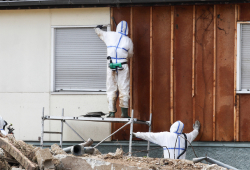Mesothelioma Causes
Mesothelioma is an aggressive cancer caused by exposure to asbestos. This naturally occurring mineral was once used in thousands of products across many industries like construction before the dangers were known to the public. Learn how asbestos causes mesothelioma, how to prevent exposure, and how those diagnosed can get help.
What Causes Mesothelioma Cancer?
 Mesothelioma is only caused by asbestos exposure. When asbestos-containing materials are disturbed, they can release microscopic fibers into the air that can be breathed in or swallowed.
Mesothelioma is only caused by asbestos exposure. When asbestos-containing materials are disturbed, they can release microscopic fibers into the air that can be breathed in or swallowed.
The fibers won’t leave the body and can trigger the growth of mesothelioma cancer tumors 10-50 years after exposure.
Millions of people were put at risk of mesothelioma due to asbestos exposure between the 1930s and early 1980s. Asbestos was widely used in industries like construction, shipbuilding, and manufacturing before the dangers were fully understood.
Contact our mesothelioma nurses now to get help finding top doctors, treatments, and compensation if you have been diagnosed with mesothelioma.
- Find Top Doctors and Treatments
- Connect You With Clinical Trials
- Answer Medical Questions

Amy Fair
20+ Years Helping
Mesothelioma Patients
Types of Mesothelioma Caused by Asbestos
There are four types of mesothelioma, and all four are caused by asbestos.
- Malignant pleural mesothelioma: The most common type that develops after asbestos is breathed in and lodges in the lining of the lungs (pleura)
- Peritoneal mesothelioma: The second-most common type that forms in the lining of the abdomen (peritoneum) after asbestos is swallowed
- Pericardial mesothelioma: A rare type of mesothelioma that develops in the lining of the heart (pericardium)
- Testicular mesothelioma: Another rare type of cancer that affects the lining of the testicles (tunica vaginalis)
Other Conditions Caused by Asbestos
There are other conditions that can be caused by asbestos, including:
- Asbestosis
- Lung cancer
- Ovarian cancer
- Pleural effusion (fluid buildup in the lung lining)
- Pleural plaques (protein buildup in the lung lining)
Some of these asbestos-related diseases can occur before or at the same time as mesothelioma, like asbestosis and pleural plaques. In fact, pleural effusions can be an early mesothelioma symptom for some patients.
How Does Asbestos Exposure Cause Mesothelioma?
Asbestos causes mesothelioma by irritating healthy tissue inside the body for decades, leading tomutations that turn normal cells into cancer cells.
Here’s how asbestos causes mesothelioma:
- Asbestos fibers are released into the air: When someone works with or around asbestos-containing products, fibers can be released. Anyone nearby could breathe in or swallow these fibers.
- Asbestos fibers get trapped in the body: Once in the body, the fibers can become lodged in different parts of the mesothelium, which is the body’s internal lining.
- Asbestos damages healthy cells: Asbestos fibers are sharp and durable and can penetrate deep into the body’s tissue.
- Mesothelioma tumors develop: Over 10-50 years, chronic inflammation and damage from asbestos fibers cause healthy mesothelial cells to become cancerous.
How much asbestos exposure causes mesothelioma? Even being exposed to asbestos fibers just once can cause mesothelioma. However, you’re at a greater risk if you were routinely exposed, such as if you worked with asbestos-containing materials at your job.
What Causes Mesothelioma Other Than Asbestos?
The only known cause of mesothelioma is asbestos. There are no other known mesothelioma causes at this time.
“If there’s no asbestos, there’s no mesothelioma, it’s that simple. If you have mesothelioma, and you say, ‘Well, I’ve never been exposed to asbestos,’ you were exposed to it. You just don’t know where and you don’t know when.”
— Dr. Raja Flores, mesothelioma specialist
Call (877) 446-5767 to get help pinpointing when, where, and how your asbestos exposure may have occurred if you’re now suffering from mesothelioma.
Mesothelioma Risk Factors
Malignant mesothelioma risk factors aren’t direct causes, but may increase the likelihood of getting sick after exposure to asbestos.
Risk factors for mesothelioma and other asbestos diseases include:
- Age: Mesothelioma takes 10-50 years to develop, so many are diagnosed later in life. The average pleural mesothelioma patient is diagnosed at age 72, according to the American Cancer Society.
- Family history: If a loved one worked with or around asbestos, you could have been exposed secondhand as fibers may have traveled home on hair or clothing.
- Gender: Men are more likely to develop mesothelioma since they often worked in high-risk asbestos occupations.
- Gene mutations: Some people may be predisposed to mesothelioma following asbestos exposure if they have certain gene mutations, according to the National Cancer Institute.
- Occupation: Occupations, like construction, auto repair, and military service, put people at risk of asbestos exposure every day, greatly increasing their risk of cancer.
- Smoking: Smoking can worsen the damage caused by asbestos. It doesn’t increase the risk of mesothelioma but makes asbestos lung cancer much more likely.
If you were exposed to asbestos, get routine screenings for mesothelioma and other cancers. These can help catch any cancers early on before they spread.
Connect with our nurses now for help.
Where Asbestos Exposure Happens


Occupational Asbestos Exposure
This is the most common way people were exposed to asbestos products. An estimated 27 million people were exposed to asbestos at their jobs between 1940 and 1979, according to the Agency for Toxic Substances and Disease Registry (ATSDR).
Jobs with a higher risk of occupational asbestos exposure included:
- Auto mechanics
- Carpenters
- Demolition workers
- Electricians
- Insulation installers
- Miners
- Pipefitters
- Plumbers
- Shipyard workers
Workers who handled asbestos-containing materials like wires, insulation, gaskets, and more weren’t informed about the risks. Manufacturers of asbestos-containing products hid the truth to make huge profits.
“I had fun being a mechanic. We knew asbestos was in things, but we didn’t know it was dangerous or that it could cause cancer or kill you.”
— Dennis Ray, mesothelioma survivor
Military Exposure
U.S. military veterans make up about one-third of mesothelioma cases diagnosed today. This is because the military used a significant amount of asbestos-containing materials for decades.
All branches of the U.S. military relied on asbestos, including the:
- Air Force: Bases and planes contained asbestos, putting gunners, mechanics, and technicians at risk
- Army: Ground vehicles, bases, and barracks were hotbeds for exposure, putting mechanics, electricians, construction workers, and more in danger
- Coast Guard: Virtually all Coast Guard ships relied on asbestos until the 1980s
- Marine Corps: Those serving in the Marines risked exposure from bases, vehicles, planes, and ships
- Navy: This branch used more asbestos than any other, putting service members at risk of exposure aboard Navy ships and in shipyards
The U.S. Department of Veterans Affairs (VA) now offers a wide range of benefits to help veterans affected by mesothelioma.
Secondhand Asbestos Exposure
Even if you did not work directly with asbestos, it is still possible to have been exposed secondhand. For example, if a family member worked in a high-risk asbestos occupation, they may have brought home fibers on their clothing, hair, or skin.
When they changed their clothes, they could have released the asbestos fibers into the air at home, which put the whole household at risk of secondary exposure.
“My father would come home from work, and I’d run up and hug him. He was covered in dust from a worksite. We didn’t know that included asbestos dust.”
— Julie Gundlach, mesothelioma survivor
Other Locations at Risk of Asbestos Exposure
Outside of workplace and military exposure, there are several ways people can be exposed to asbestos fibers.
These include:
- Older public buildings: Schools, hospitals, and government buildings built before asbestos regulations were in place may contain asbestos materials.
- Residential homes: Older homes often have asbestos-containing materials in roofing, insulation, flooring, and siding.
- Abandoned industrial operations or mines: While it is rare, some old mines had so much asbestos contamination that the nearby soil and water may still be contaminated.
If you or someone you love was exposed to asbestos and developed mesothelioma, we can help you access treatment and other resources. Speak with our on-staff nurses today to see how we can help.
- Find Top Doctors and Treatments
- Connect You With Clinical Trials
- Answer Medical Questions



Amy Fair
20+ Years Helping
Mesothelioma Patients
Ways to Reduce Mesothelioma Risk
The only way to prevent mesothelioma is to prevent exposure to asbestos. Once you’re exposed, there’s no way to eliminate the risk of developing mesothelioma or another asbestos-related disease.
You can lower the risk of asbestos exposure in your community by:
- Adhering to safety regulations when working with or around asbestos
- Advocating for strict regulations and bans on asbestos use in your town or city
- Ensuring asbestos removal and handling are carried out by trained professionals
- Getting regular health checkups if you were exposed to asbestos
It’s also important to note that you may qualify for compensation from manufacturers of asbestos-containing products through a mesothelioma lawsuit.
Mesothelioma lawsuits award $1 million or more on average. While this can’t undo your diagnosis, it can help you afford mesothelioma treatments to improve your quality of life and potentially live longer.
Mesothelioma Causes and Next Steps
If you have mesothelioma, you were exposed to asbestos at some point in your life.
You don’t have to fight mesothelioma alone. At Lung Cancer Group, we may be able to help you determine how asbestos caused mesothelioma and pursue resources to make life easier.
We can assist with:
- Determining when, where, and how you were exposed to asbestos
- Finding top doctors and treatments for mesothelioma
- Pursuing compensation to cover mesothelioma cancer expenses
Get started by connecting with our mesothelioma nurses or calling (877) 446-5767. Our dedicated team is ready to help you and your family in any way we can after a mesothelioma diagnosis.
Malignant Mesothelioma Causes FAQs
What is the main cause of mesothelioma?
The only known mesothelioma cause is asbestos exposure. Asbestos fibers cause mesothelioma by irritating the linings of internal organs for decades.
After 10-50 years, this damage causes healthy cells to become cancerous. The cells then grow into mesothelioma tumors that can spread throughout the body.
Who mostly gets mesothelioma?
Those who mostly get mesothelioma worked with asbestos at their jobs for long periods. Construction workers, shipbuilders, and military veterans are among those at the highest risk.
However, anyone with a history of asbestos exposure could develop mesothelioma, regardless of their occupation.
Contact our team now for help if you or a loved one has developed mesothelioma. You may qualify for treatments and compensation.
Can smoking cause mesothelioma?
Smoking does not cause mesothelioma — only asbestos does. The National Cancer Institute notes that smoking doesn’t increase the risk of mesothelioma among those exposed to asbestos.
However, smoking greatly increases the odds of lung cancer in people who suffered asbestos exposure, according to a study from the International Journal of Environmental Research and Public Health.
Those who worked with or around asbestos-containing materials should quit smoking and get regular screenings for cancer to protect their health.
How does asbestos cause peritoneal mesothelioma?
Disturbed asbestos fibers that are released into the air can be swallowed without notice. These fibers can then make their way into the abdominal lining and cause damage. This can trigger peritoneal mesothelioma 10-50 years later.
Contact our mesothelioma nurses now to find top doctors and treatments if you developed any type of this rare cancer.
What is mesothelioma caused by?
Mesothelioma is caused by asbestos fibers. If the fibers enter the body, they can cause decades of irritation that leads to the development of malignant cells and tumors.
There’s no other mesothelioma causes, but factors like age, if you worked with asbestos, and overall health can make the development of this cancer more likely.
What are childhood mesothelioma risk factors?
It’s incredibly rare for children and teenagers to develop mesothelioma, but it has happened. The only known childhood mesothelioma cause is exposure to asbestos.
Children may be put at risk of mesothelioma if their family members worked with or around asbestos-containing products.
What are the early warning signs of mesothelioma?
The early warning signs and symptoms of mesothelioma can be subtle and often mimic symptoms of other less severe conditions.
Common early symptoms of mesothelioma include:
- A cough that won’t go away
- Chest pain
- Fatigue
- Fluid buildup in the chest wall and lining
- Shortness of breath
- Weight loss
Seek medical attention if you have a history of asbestos exposure and experience any of these symptoms. There’s no known mesothelioma causes besides asbestos, so those who’ve been exposed should take precautions.
Doctors can use imaging scans like X-rays, blood tests, and biopsies to help confirm a diagnosis, and from there, recommend treatment options to help improve your life expectancy.

